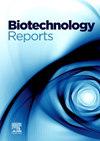Sargassum incisifolium and Ulva spp metabolites activity and their molecular dynamics simulation against Fusarium oxysporum 14-alpha-demethylase
Q1 Immunology and Microbiology
引用次数: 0
Abstract
Fusarium oxysporum, a major agricultural pathogen, poses severe risks to crops worldwide. With increasing resistance to conventional antifungal agents, there is an urgent need for alternative treatments. Seaweeds such as Ulva spp. and Sargassum incisifolium are promising sources of bioactive compounds that may offer novel antifungal properties. This study investigates the antifungal activity of acetone extracts from Ulva spp. and Sargassum incisifolium against F. oxysporum, with the goal of identifying specific bioactive compounds responsible for this activity and evaluating their effectiveness quantitatively. We prepared acetone extracts from both seaweed species and assessed their antifungal activity using a series of in vitro assays. The total phenolic content (TPC) and antioxidant capacity were determined for each extract. LC-qTOF-MS/MS was employed for phytochemical profiling, while molecular docking and molecular dynamics simulations were used to predict interactions between identified compounds and the 14-alpha-demethylase enzyme of F. oxysporum. The TPC was 2.72±0.009 and 2.23±0.009 GAE/mg dry weight for Ulva spp and S. incisifolium. Additionally, significant antioxidant activity was observed, with IC50 values of 8.38±0.06 µg/mL for Ulva spp and 8.01±0.07 µg/mL for S. incisifolium, which are comparable to ascorbic acid (5.23±0.04 µg/mL). Phytochemical analysis revealed high levels of terpenoids, phenolics, and fatty acids. In molecular docking, compounds such as medicocarpin, corynanthine, and merulinic acid demonstrated strong binding affinities (binding energies ≤ -7.5 kcal/mol). Molecular dynamics simulations confirmed stable interactions over 100 ns, with medicocarpin exhibiting the most stable binding profile. The study demonstrates that acetone extracts of Ulva spp. and S. incisifolium possess significant antifungal activity against F. oxysporum. Medicocarpin, in particular, emerged as a promising candidate for further development as an antifungal agent. These findings underscore the potential of seaweed-derived compounds as antifungal agents against fungal pathogens and highlight the need for further investigation into their practical applications in plant disease management. Specifically, Medicocarpin emerged as a promising in silico candidate, warranting further experimental validation.
切尾马尾草和Ulva spp代谢物对尖孢镰刀菌14- α -去甲基酶的活性及其分子动力学模拟
尖孢镰刀菌(Fusarium oxysporum)是一种重要的农业病原菌,对全球农作物造成严重威胁。随着对常规抗真菌药物的耐药性增加,迫切需要替代治疗。海藻如Ulva spp.和马尾藻(Sargassum incisifolium)是有希望的生物活性化合物来源,可能提供新的抗真菌特性。本研究研究了乌尔玛和切尾马尾草丙酮提取物对尖孢镰刀菌的抑菌活性,目的是鉴定其抑菌活性的特异性生物活性化合物,并定量评价其抑菌活性。我们从这两种海藻中提取丙酮提取物,并通过一系列体外实验评估其抗真菌活性。测定各提取物的总酚含量(TPC)和抗氧化能力。采用LC-qTOF-MS/MS进行植物化学分析,分子对接和分子动力学模拟预测鉴定化合物与尖孢霉14- α -去甲基酶的相互作用。榆木和切叶草的TPC分别为2.72±0.009和2.23±0.009 GAE/mg干重。此外,还观察到显著的抗氧化活性,Ulva spp的IC50值为8.38±0.06µg/mL,而S. incisifolium的IC50值为8.01±0.07µg/mL,与抗坏血酸5.23±0.04µg/mL相当。植物化学分析显示萜类、酚类和脂肪酸含量很高。在分子对接中,medicocarpin、corynanthine、merulinic acid等化合物表现出很强的结合亲和力(结合能≤-7.5 kcal/mol)。分子动力学模拟证实了超过100 ns的稳定相互作用,其中medicocarpin表现出最稳定的结合谱。研究表明,紫叶橐吾和切叶橐吾的丙酮提取物对尖孢镰刀菌具有显著的抗真菌活性。特别是Medicocarpin,作为一种抗真菌药物,它是一种有希望进一步开发的候选药物。这些发现强调了海藻衍生化合物作为真菌病原体抗真菌剂的潜力,并强调了进一步研究其在植物病害管理中的实际应用的必要性。具体来说,Medicocarpin作为一种有前途的硅候选物出现,需要进一步的实验验证。
本文章由计算机程序翻译,如有差异,请以英文原文为准。
求助全文
约1分钟内获得全文
求助全文
来源期刊

Biotechnology Reports
Immunology and Microbiology-Applied Microbiology and Biotechnology
CiteScore
15.80
自引率
0.00%
发文量
79
审稿时长
55 days
期刊介绍:
Biotechnology Reports covers all aspects of Biotechnology particularly those reports that are useful and informative and that will be of value to other researchers in related fields. Biotechnology Reports loves ground breaking science, but will also accept good science that can be of use to the biotechnology community. The journal maintains a high quality peer review where submissions are considered on the basis of scientific validity and technical quality. Acceptable paper types are research articles (short or full communications), methods, mini-reviews, and commentaries in the following areas: Healthcare and pharmaceutical biotechnology Agricultural and food biotechnology Environmental biotechnology Molecular biology, cell and tissue engineering and synthetic biology Industrial biotechnology, biofuels and bioenergy Nanobiotechnology Bioinformatics & systems biology New processes and products in biotechnology, bioprocess engineering.
 求助内容:
求助内容: 应助结果提醒方式:
应助结果提醒方式:


